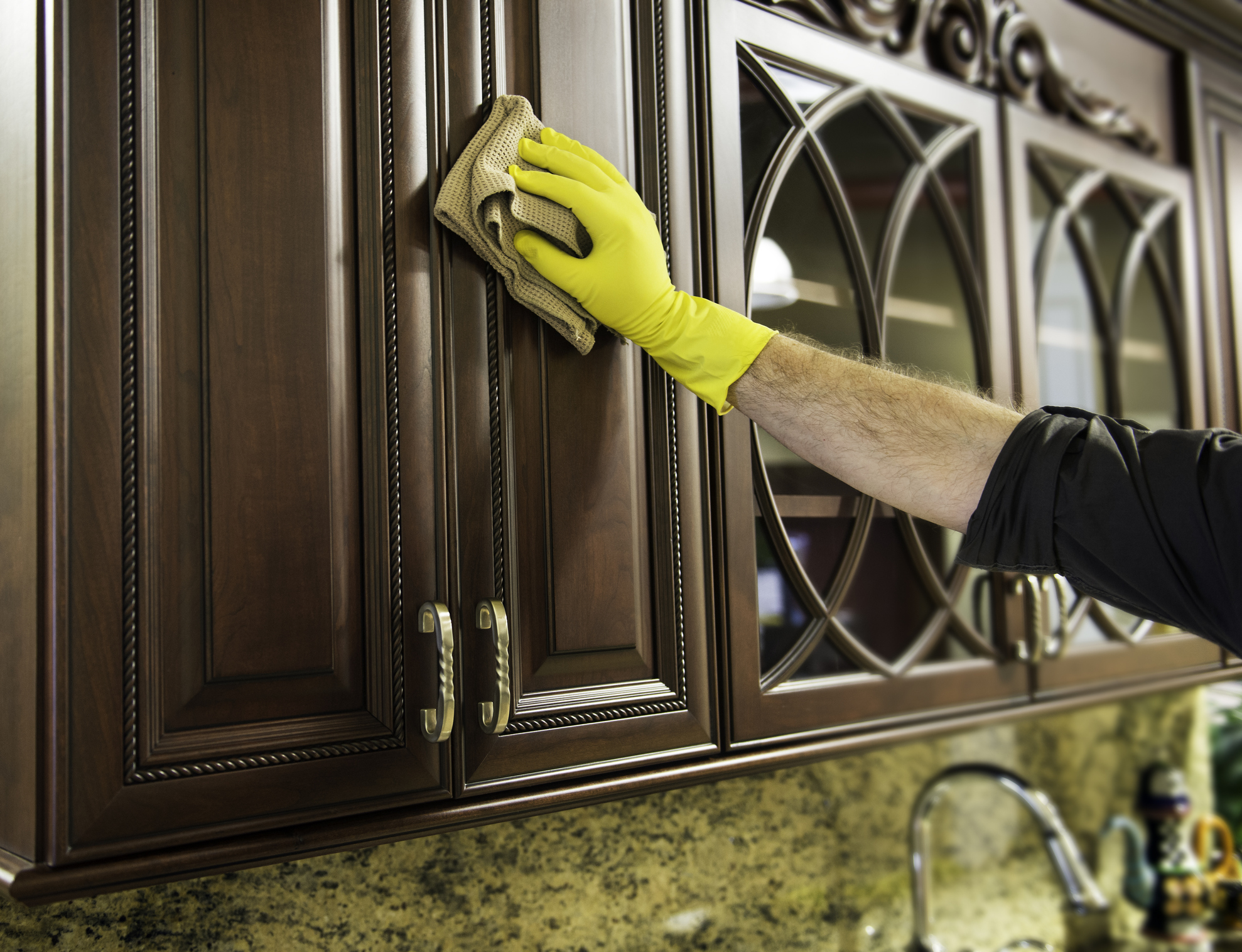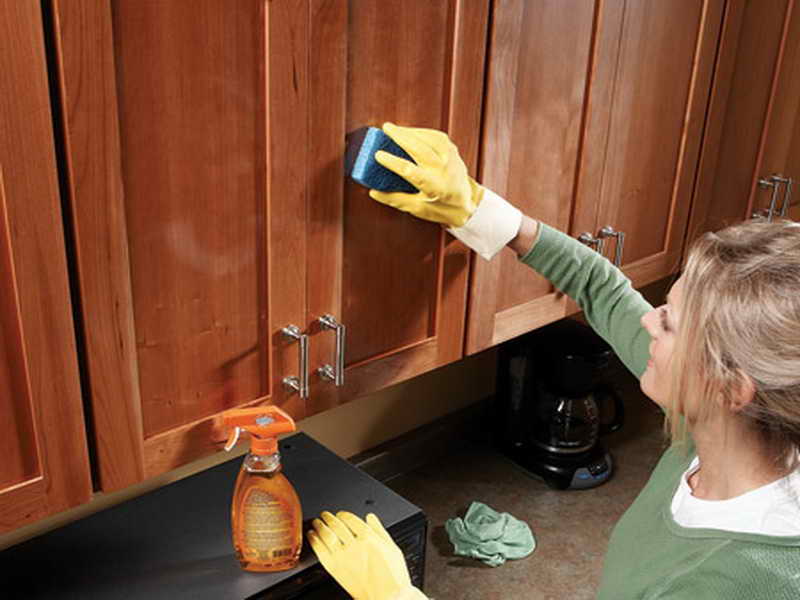Understanding Wood Cabinet Surfaces

Before diving into the cleaning process, it’s crucial to understand the different types of finishes commonly found on wood cabinets. Each finish has unique properties that influence the cleaning methods and products you should use.
Types of Wood Finishes
The type of finish applied to your wood cabinets significantly impacts how you clean them. Here are some common finishes:
- Varnish: A protective coating that creates a hard, durable surface. It’s often used on kitchen cabinets due to its resistance to scratches, heat, and moisture.
- Lacquer: A fast-drying, clear coating that provides a smooth, glossy finish. It’s often used on furniture and cabinets because of its durability and resistance to stains.
- Paint: A pigmented coating that can be applied in various colors and finishes, providing both protection and aesthetics. It’s a popular choice for cabinets, offering versatility and customization.
- Stain: A pigmented coating that penetrates the wood, enhancing its natural color and grain pattern. It’s often used on cabinets to create a more rustic or traditional look.
Cleaning Considerations for Different Finishes
Each type of finish requires a different approach to cleaning.
- Varnish and Lacquer: These finishes are relatively durable and can withstand mild cleaners. Use a damp cloth with a mild soap solution or a specialized wood cleaner. Avoid abrasive cleaners or harsh chemicals that can damage the finish.
- Paint: Painted cabinets are generally easier to clean than those with varnish or lacquer. You can use a damp cloth with a mild soap solution or a specialized paint cleaner. Avoid abrasive cleaners that can scratch the paint.
- Stain: Stained cabinets are more susceptible to damage from harsh cleaners. Use a damp cloth with a mild soap solution or a specialized wood cleaner. Avoid using abrasive cleaners or chemicals that can strip the stain.
Identifying the Type of Finish, Wood cabinet cleaner diy
Identifying the type of finish on your cabinets can help you choose the appropriate cleaning methods.
- Visual Inspection: Examine the finish closely. Varnish and lacquer typically have a glossy or semi-gloss appearance, while paint can have various finishes, including matte, satin, or gloss. Stain often has a more natural, textured appearance, showcasing the wood’s grain.
- Touch Test: Gently touch the surface. Varnish and lacquer feel smooth and hard, while paint can feel slightly textured depending on the finish. Stain often feels rougher, reflecting the wood’s grain.
- Water Test: Apply a drop of water to an inconspicuous area. If the water beads up, the finish is likely varnish or lacquer. If the water absorbs, the finish is likely paint or stain.
DIY Wood Cabinet Cleaner Recipes: Wood Cabinet Cleaner Diy

Now that you understand the basics of wood cabinet surfaces, let’s dive into some simple and effective DIY cleaning recipes. These recipes use common household ingredients that are gentle on your cabinets and won’t break the bank.
DIY Wood Cabinet Cleaner Recipes
Here are three different DIY wood cabinet cleaner recipes you can try:
Recipe 1: Simple Vinegar and Water
- Purpose of Ingredients:
- Vinegar: Vinegar acts as a natural cleaning agent, effectively removing dirt, grime, and fingerprints. Its acidic nature helps to break down grease and oil, leaving your cabinets sparkling clean.
- Water: Water helps to dilute the vinegar, making it less harsh on your wood surfaces. It also acts as a carrier for the vinegar, allowing it to spread evenly across the surface.
- Mixing Instructions: Combine equal parts white vinegar and water in a spray bottle. For example, you can mix 1 cup of vinegar with 1 cup of water.
- Application Instructions: Spray the mixture onto a soft cloth or paper towel and wipe down your cabinets. Rinse the surface with a clean, damp cloth to remove any residue. Allow the cabinets to air dry completely.
Recipe 2: Olive Oil and Lemon Juice
- Purpose of Ingredients:
- Olive Oil: Olive oil acts as a natural conditioner, helping to nourish and protect the wood surface. It also leaves a beautiful shine on your cabinets.
- Lemon Juice: Lemon juice is a natural disinfectant and cleaner, helping to remove dirt and grime. It also helps to brighten the wood surface and leave a pleasant citrus scent.
- Mixing Instructions: Combine 1/4 cup of olive oil with 2 tablespoons of lemon juice in a small bowl. Mix well until the ingredients are evenly combined.
- Application Instructions: Apply the mixture to a soft cloth and rub it gently onto your cabinets. Let the mixture sit for a few minutes, then buff the surface with a clean, dry cloth to remove any excess oil.
Recipe 3: Baking Soda and Water
- Purpose of Ingredients:
- Baking Soda: Baking soda is a mild abrasive that can help to remove stubborn stains and grime. It also acts as a natural deodorizer, leaving your cabinets smelling fresh.
- Water: Water helps to create a paste from the baking soda, making it easier to apply to the cabinets. It also helps to dilute the baking soda, making it less abrasive on the wood surface.
- Mixing Instructions: Combine baking soda with a small amount of water to form a paste. You may need to adjust the amount of water depending on the consistency of the paste.
- Application Instructions: Apply the paste to a soft cloth and gently rub it onto the stained areas of your cabinets. Let the paste sit for a few minutes, then rinse it off with a clean, damp cloth. Allow the cabinets to air dry completely.
Cleaning and Maintaining Wood Cabinets

Now that you’ve created your DIY wood cabinet cleaner, it’s time to put it to use! Cleaning your wood cabinets regularly will not only keep them looking their best but also help to protect them from damage.
Cleaning Wood Cabinets with a DIY Cleaner
To clean your wood cabinets, you will need your DIY cleaner, a soft cloth, and a bucket of warm water. Follow these steps:
- Prepare the Cabinets: Clear any items from the cabinet shelves and drawers. This will give you easy access to all surfaces.
- Dust the Cabinets: Use a soft cloth to dust the cabinets, removing any loose dirt or debris. This will prevent scratches when you apply the cleaner.
- Apply the Cleaner: Dampen a clean cloth with your DIY cleaner. Avoid soaking the cloth, as too much moisture can damage the wood. Gently wipe down the cabinet surfaces, working in the direction of the wood grain.
- Rinse and Dry: Wipe down the cabinets with a clean, damp cloth to remove any residue from the cleaner. Then, dry the cabinets thoroughly with a soft cloth.
Removing Stains and Marks
Different types of stains require different removal techniques. Here are some tips for removing common stains from wood surfaces:
- Water Stains: For water stains, try applying a paste made from baking soda and water. Let the paste sit for a few minutes, then gently rub it into the stain with a soft cloth. Rinse the area with clean water and dry thoroughly.
- Grease Stains: For grease stains, use a mixture of equal parts white vinegar and water. Apply the mixture to the stain with a soft cloth, then wipe it clean. Repeat as needed until the stain is gone.
- Ink Stains: For ink stains, try rubbing alcohol. Apply a small amount to a cotton ball and gently rub it onto the stain. Be careful not to rub too hard, as this can damage the wood. Rinse the area with clean water and dry thoroughly.
Preventing Damage and Maintaining Appearance
To prevent future damage and maintain the appearance of your wood cabinets, follow these tips:
- Avoid Harsh Chemicals: Avoid using harsh chemicals, such as bleach or ammonia, on your wood cabinets. These chemicals can damage the finish and cause discoloration.
- Use Coasters: Place coasters under glasses and other beverages to prevent water rings from forming on the cabinet surfaces.
- Avoid Heat and Moisture: Keep your wood cabinets away from direct sunlight and heat sources, such as radiators or ovens. Also, avoid placing hot dishes or appliances directly on the cabinet surfaces.
- Regular Cleaning: Dust and clean your wood cabinets regularly to prevent dirt and grime from building up. This will help to maintain their beauty and longevity.
Wood cabinet cleaner diy – A gentle DIY wood cabinet cleaner can work wonders, but sometimes, a deeper transformation is desired. If you’re looking to shed the old stain and embrace a fresh new look, consider how to paint over stained wood cabinets.
This process may require a more robust cleaner to remove any lingering residue before applying the paint, ensuring a smooth and lasting finish.
A DIY wood cabinet cleaner can be a great way to keep your kitchen’s surfaces gleaming, especially if you have a beautiful cherry wood kitchen pantry cabinet. But be careful – some cleaners can leave a residue that dulls the natural luster of the wood.
Always test your cleaner on a hidden area first to ensure it doesn’t damage the finish. After all, you want your pantry cabinet to remain a timeless treasure, not a faded relic.
